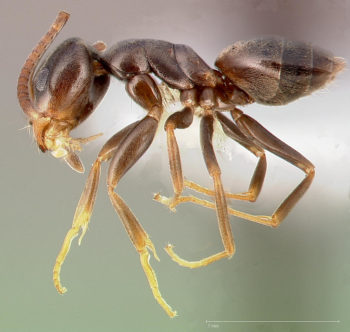Idaho is home to some of the most beautiful and diverse wildlife in the world. This, unfortunately, includes invasive insects like ants. The average person does not think about ants, until the ants end up invading their home. Here are a few answers to the question: “How did these ants get in my house?!”

While seeing a line of these tiny guys leading out of your pantry is not a pleasant surprise to get with your morning coffee, there are plenty of ways to solve your ant problems. The first step is to identify HOW exactly they got into your house in the first place. The most common ant found in Idaho is called the “odorous ant” and is also known as the “sugar ant, stink ant, and coconut ant (https://en.wikipedia.org/wiki/Tapinoma_sessile).” These little brown ants love sugar, soda, and anything sweet. Here’s how they will typically get into your house to chow down on your pantry:
From Above
Ants are nothing if not strong and fast. It’s estimated that they can lift over 3,000 times their body weight, which makes them great climbers. Ants will typically get into your house through the roof. Ants, especially the Idahoan sugar ant, can build their colonies in and around trees. Look around your house to see if you have any branches touching your roof or outside wall. If you do, then that could be a perfect way for ants to get a foothold in your abode.
Also, look for power/utility lines that may lead into your house from the street. Many older houses will have a power line going directly from the pole in the street to their roof. An ant colony at the base of that pole can easily make their way up and over to your roof by following the line. Take a walk around the perimeter of your house and take note of what is touching your house.
From Below
Ants are attracted to heat and moisture and especially when they find both in one place. Check the seals around your outside doors, especially the bottom plates. If they are torn or misaligned, they could be seeping warm air outside. If a scouting ant discovers this, they may bring backup to forage for food in your house, especially during the colder months.
Check your garage as well. Ants are oftentimes found inhabiting cracks in driveways, which puts your garage front and center. They can easily slip under a poorly sealed garage door. Make sure every window and door to the outside of your house is properly sealed in order to prevent an ant infestation.
Pro Tips:
- When it’s time to replace the seal on your garage door, look for the name of the manufacturer on the door itself and not on the remote or motor unit.
- Take a three inch cutting of the garage door seal to your neighborhood hardware store so they can match it to your particular door.
- When replacing the seal, make sure you cut it about six inches longer than your actual door. This will help keep it in place during extreme temperature variations.
Remember, your local pest control company should be your first call if you discover ants or other unwanted critters in your home. Give them a call first before you spend your hard earned money on store bought remedies. Oftentimes, a pest control professional will be able to give you a free consultation or even help you solve the problem right there over the phone. At Capitol Pest, we are happy to give you friendly, free advice right over the phone. Call today!

